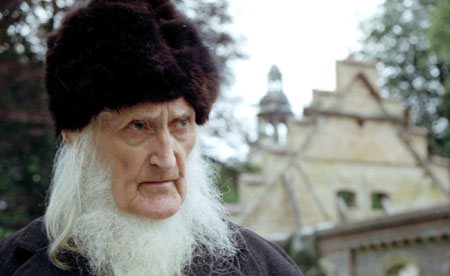|
Reviews of Recent Independent, Foreign, & Documentary Films in Theaters and DVD/Home Video
Director of Photography & Directed by: Pernille Rose Grønkjaer. Produced by: Sigrid Dyekjaer. Editor: Pernille Bech Christensen. Music: Johan Söderqvist. Released by: Koch Lorber Films. Language: English, Danish & Russian with English subtitles. Country of Origin: Denmark. 84 min. Not Rated. A shambling, tall thin man in his eighties with long hair and a white beard cleans a damp, crumbling 19th-century castle in rural Denmark, waiting for the arrival of a small scouting party of Russian nuns whom he has invited to set up home there. This is the opening sequence of an enchanting documentary by young Danish director Pernille Rose Grønkjaer of how, after many difficulties and personality clashes, Jørgen Lauersen Vig’s dream of a Russian Orthodox monastery within his castle became a reality. Mr. Vig encounters a young and energetic Russian nun named Amvrosija, who refuses simply to patch together the crumbling structure. She insists on a roof that does not leak and radiators that work. She also demands, much more controversially, on setting her community on a sensible legal footing, leading to many altercations and some hostile venting toward the Russian. The film’s focus is very much on the opinionated Mr. Vig himself. All the action is shown through his eyes. He is candid – almost too much so – about the emotional stunting of his childhood, his love-hate relationship with his demanding father, the lack of warmth in his personal life. We learn much less about Nun Amvrosija, despite her appealing personality and excellent English. During the long renovation, Grønkjaer creates a story of transformation and redemption. The monastery that Vig establishes will fulfill his dreams, but only after changing them. In the end, Vig gains a community that loves him, prays for him, and mourns for him. Beauty – or at least spiritual beauty – chooses to settle in the Beast’s castle.
But the reality has to be far more complex. Vig owned Hesbjerg Castle from 1957 to
his death in 2005. In that time it housed experiments in drug rehabilitation,
East-West political dialogue, and Christian-Buddhist dialogue, to name a few.
Vig was a polymathic religious intellectual of vast reading, as the film only
barely suggests. Grønkjaer’s image of the child grown old is a lovely but
partial cameo. Did Vig play along with his director’s ideas, or did she contrive
the portrait through artful editing? Does it matter? This is a beautiful, moving,
gentle film, however incomplete it may be.
Euan Cameron,
Academic Dean and Henry Luce III Professor of Reformation Church History,
Union Theological Seminary
|

